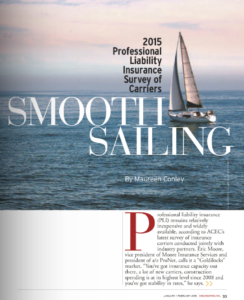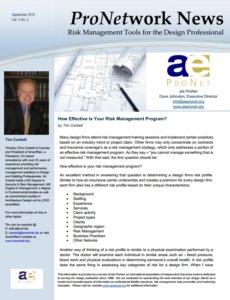 Design professionals are often asked by their clients to sign contracts that include comprehensive—sometimes unreasonable—insurance requirements and indemnification terms. These are usually drafted with the goal of protecting owners, clients, contractors, or other project participants. But how does this work when the required coverages aren’t found in the commercial insurance marketplace?
Design professionals are often asked by their clients to sign contracts that include comprehensive—sometimes unreasonable—insurance requirements and indemnification terms. These are usually drafted with the goal of protecting owners, clients, contractors, or other project participants. But how does this work when the required coverages aren’t found in the commercial insurance marketplace?
Certificates of insurance (COIs)—which are also often requested in those professional service contracts—provide summaries or verification of current coverage, including policy effective dates, insurers, and certain policy limits. A certificate gives a snapshot to the requestor (usually known as the certificate holder) for informational purposes. It’s important to understand that in no way does a certificate endorse, amend, alter, or extend coverage; nor does it act as a contract. Certificates are often provided using a set of industry standard forms produced by ACORD (formally known as the Association for Cooperative Operations Research and Development), which indicate:
THIS CERTIFICATE IS ISSUED AS A MATTER OF INFORMATION ONLY AND CONFERS NO RIGHTS ON THE CERTIFICATE HOLDER. THIS CERTIFICATE DOES NOT AMEND, EXTEND OR ALTER THE COVERAGE REPORTED BY THE POLICIES DESCRIBED BELOW.
Issuers of COIs generally strive to accurately reflect the insurance policies that are in effect, but those who are relying on the forms need to keep in mind that it’s virtually impossible to summarize an insurance policy of over a hundred pages in a form that contains a few boxes. Adding to this, those who are issuing insurance certificates often struggle as they try to confirm in a COI that specific and detailed contractual requirements are—or aren’t—being met.
One common challenge is meeting a request that an insurer provide notice of a policy’s cancellation to the insured’s clients. To do so, the insurer would need to track all such requirements for all insureds for the duration of each contractual requirement—which may even be unspecified. With this in mind, ACORD made changes in 2010 to clarify that insurers’ notification duties are as defined in the insurance policy, not in the professional services contract.
Generally, courts agree that a certificate of insurance is not a contract. One fundamental reason is that no consideration—or payment—is given by the certificate holder to the issuer. However, there is a duty to make accurate representations within the confines of the overall system. To consider this, we’ll review a few recent cases interpreting the obligations for COIs and their issuers. Continue reading “Certificates of Insurance: Why You Can’t Always Have It Your Way”








